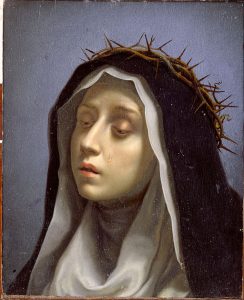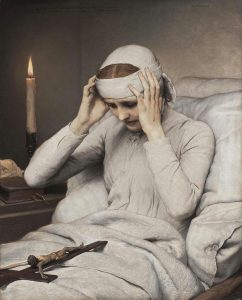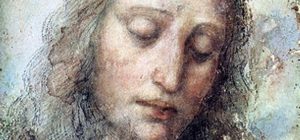Christian Mystics and the Passion of Jesus
Generations of Christians have been inspired by the holiness and vivid revelations of mystics like St. Bridget of Sweden (+1373), St. Catherine of Siena (+1380) and Catherine Anne Emmerich. (+1824). Their writings still attract believers.
Who are the mystics?
The word itself, “mystic,” comes from the Greek verb that means to close oneself off, to shut one’s eyes. The mystics appear so concentrated on God that they seem to see hardly anything else. Some leave spiritual writings and reports of visions, but many leave no writings, no reports of visions at all. That’s because mysticism is not about producing visions but pursuing God.
Though mystics can be reclusive, some live embattled lives. Bridget of Sweden, for example, a powerful instrument for 14th century church reform, charged popes, bishops, priests and secular rulers with causing suffering to Jesus and his church by their abuse of authority. The Swedish noblewoman’s stern warnings are often found in the midst of her meditations on Jesus’ passion, which she paints in violent brush strokes meant to jolt her lax hearers.
Through the centuries, detailed descriptions of gospel stories by mystics have furnished artists, writers and dramatists with plentiful material for presenting the Christian mysteries. Artists and writers of the middle ages especially turned to them for depictions of the life of Jesus, particularly his passion and death. Mystics have helped shape the Christian imagination as well as many Christian devotional practices.
Their love of the Passion of Jesus
A favorite subject for Christian mystics is the passion of Jesus, which they see as a powerful sign of God’s love. It also provides them with a way to look at their own society and to understand the experience they have in their personal search for God. For them Calvary is a place where one sees everything.
Largely through them, some incidents that are not contained in the gospels of the passion have become etched into the popular imagination. One thinks of the poignant scene of Mary, holding in her arms the dead body of Jesus her son after his crucifixion– the Pieta. The gospels say nothing about it. Yet the mystics generally took for granted that Mary not only had a part in his removal from the cross but in so many other events of his passion as well. They saw her hurrying to be with him after his arrest. She was there when he was judged, when he was pushed on his way to Calvary. She stood beneath his cross and remained with him as long as she could. The mother’s presence at the death of her son added a powerful human dimension to the gospel story.
Mystics and pilgrims also influenced the creation of devotions like the Stations of the Cross, a prominent devotion of the western church. It presents Jesus falling three times on his way to Calvary, falls not mentioned in the gospels yet surely plausible, considering the weakness he suffered from his scourging.
The Stations of the Cross offers an interesting parallel to the gospels. It begins with the condemnation of Jesus by Pilate, and so concentrates on the crucial role of the Roman Procurator — as the creedal formula does: “he suffered under Pontius Pilate.” Roman soldiers take him away and crucify him. A Jewish trial does not appear.
The devotion highlights sympathetic Jewish participants. Besides Mary his mother, there is Veronica, who wipes the face of Jesus. Her story is not found in the gospel. Then there is Simon of Cyrene who helps Jesus carry his cross, the Jewish women who mourn him as he passes, the Pharisee Nicodemus who takes him down from the cross and buries him — figures appearing also in the scriptures.
What authority do mystics have?
What credence should we give to the mystics? They are usually the first to offer disclaimers for themselves and their work. The unknown 13th century Tuscan Franciscan who wrote “The Meditations on the Life of Christ,” a medieval best-seller, invites his original reader, probably a Poor Clare nun whose name was Cecilia, to take the book and read it — not as a scholar, but as a believer trying to nourish her mind and heart.
Not everything Jesus did is found in scripture, he says; we can use our own imaginative powers to consider his life. And so the writer adds details to the gospel story in order to help his reader enter and see, hear and feel the gospel incidents. His stories are plausible enough; they might have happened that way.
Stories flow colorfully from his pen; he is a medieval scriptwriter who knows how to capture his readers’ attention. Yet, he admits that his stories are not the same as the scripture, God’s word. That is the supreme authority from which one begins and to which one returns. It is the norm for all prayer and meditation. What he writes is secondary; you can take it or leave it.
Judging the mystics
Pope Benedict XIV, probably the best official church guide for judging saintly mystics and their revelations, offers this recommendation: “We say that their revelations, although approved, cannot be assented to by Catholic faith, but only human faith, following the rules of prudence.”(De canon.III, liii,no15)
The theologian, Melchior Cano, puts it this way: “It matters little whether or not one believes in St. Bridget’s revelations or those of other saints. These things have nothing to do with faith.” (De locis theologicis, Bk XII,iii)
The church teaches, then, that the writings of the mystics must conform to the teachings of faith; they may nourish faith, but they do not decide the substance of faith. Their writings do not supplant the scriptures, which along with the sacraments are the most important sources that Christians have for nourishing their faith. They should not wander too far away from the paths of scripture. What mystics say should be examined prudently, which means there should be a certain reasonableness and plausibility in their words, especially when they deal with scriptural events.
The church respects mystics because they open our eyes to a spiritual world. Some of them she recognizes as saints. However, she does not vouch for the visions of her saints, but only the heroic virtues of their lives.
Historically reliable?
Jesuit Father Auguste Poulain, an authority on mystical prayer, advises a cautious approach to writings of the mystics when they describe the life of Jesus and biblical events. In his extensive study “The Graces of Interior Prayer” (St.Louis 1911), in which he examines the works of 31 mystics, including Catherine Emmerich and Mary of Agreda, he finds occasional errors and contradictions, as one tells the story differently from another.
Some argue that divine guidance preserves the mystics from error because of their closeness to God. But Poulain disagrees, especially when it comes to historical details. “We see, then, that it is imprudent to seek to remake history by the help of the saints’ revelations,” he writes, likening the mystics to various painters who paint the same scene differently according to their personal styles.
Anti-Semitism
Mel Gibson’s movie “The Passion of the Christ” raises other concerns about the mystics besides their historical accuracy. Do some of them fuel anti-Semitic views by their writings on the Passion of Jesus? They surely don’t intend to; for them the Passion of Jesus primarily involves us all; we were all there when Jesus was crucified and we all share the blame and the blessing of this mystery.
Yet, did they reflect some of the anti-Semitism present in their own society in their writings? Sometimes they did, and so any anti-Semitic element found in them must be discounted.
Finding Jesus with the mystics
Discounting the mystics altogether, however, deprives us of their considerable gifts. They represent the praying church. They model the full attention, mind and heart, that believers should bring to what Jesus said and did. They are ardent, restless believers, searching into the mystery of God. We should learn from them.
From them, too, we can learn to keep the Passion of Jesus in mind. Christian mystics of the past saw the Passion of Jesus as their great book, a fount of wisdom, and they kept it constantly in their minds and hearts. True, they did not have the scholarly tools to understand it that we have today. Their search into this mystery was incomplete–as ours will be, too. But they call the church to keep remembering and learning from it.
There are not enough books or movies or meditations in this world to contain it.
Victor Hoagland, CP
(Side Bar)
Catherine Anne Emmerick
Catherine Anne Emmerick, rumored to be one of Gibson’s sources for his screenplay, had extensive visions of the Passion of Jesus. Poor and unhealthy from childhood, she entered an Augustinian convent in Westphalia, Germany in 1802, but left in 1811 when the convent was closed by the government. About a year later she showed signs of the stigmata on her body, which drew the curious to her. Among them was the German Romantic poet, Clemens Brentano, who had recently been reconciled to the church after a period of unbelief.
Impressed by Catherine, Brentano wrote down the experiences she communicated to him in two books, one of which was entitled “The Dolorous Passion of Our Lord and Savior Jesus Christ.” The book became popular among religious readers, but it presents certain difficulties. Some scholars say that it is not easy to separate what material comes from Catherine and what from him. The poet reports that he listened to Catherine and then went home and wrote down later what he remembered.
Another of the book’s weaknesses is its lack of a solid scriptural basis. Her biographer says that Catherine “never considered her visions to have any reference to her exterior Christian life, nor did she regard them as being of any historical value. Exteriorly she knew and believed nothing but the catechism, the common history of the Bible, the gospels for Sundays and festivals, and the Christian almanac…She had never read the Old or the New Testaments, and when she was tired of relating her visions, she would sometimes say: ‘Read that in the Bible,’ and then be astonished to learn that it was not there..,”
Why, then, were Catherine’s visions so popular? Perhaps because she lived during the Age of Reason, when human reason questioned everything, especially religion. Enlightenment scholars like David Frederich Strauss and Hermann Reimarus, were creating a climate of doubt about the fundamental beliefs of Christianity as they embarked on their quest of the “historical Jesus.” In an age whose patron saint was “Doubting Thomas,” Catherine’s visions of Jesus, so concrete, immediate and definite, provided large numbers of believers with the assurance they sought. q
—Victor Hoagland, C.P.





